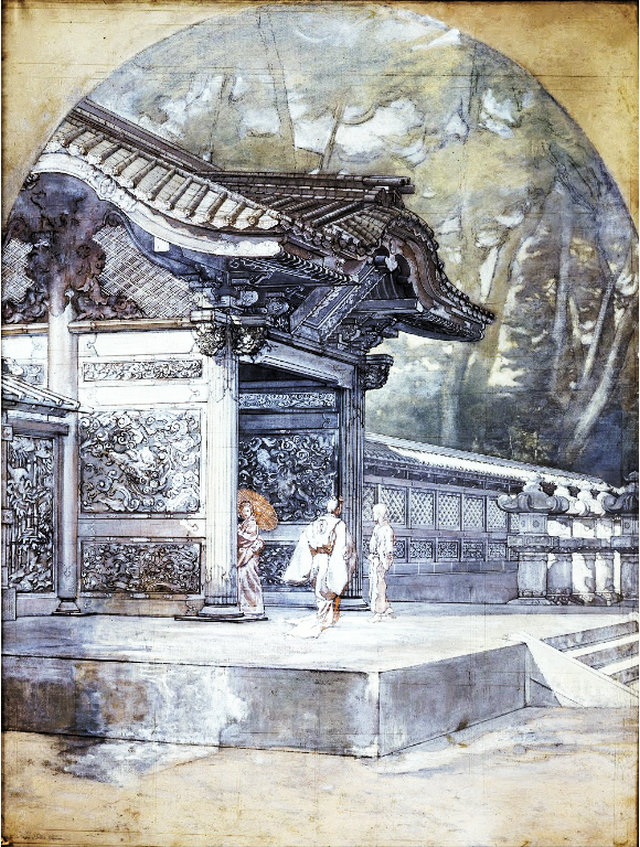Antonio Fontanesi (Reggio Emilia, February 23, 1818 – Turin, April 17, 1882) was an Italian painter and engraver who lived in Meiji period Japan between 1876 and 1878. He introduced European oil painting techniques to Japan, and exerted a significant role in the development of modern Japanese yōga painting. He is known for his works in the romantic style of the French Barbizon school.
He was a painter of landscapes, his fluid style based on chiaroscuro (which distinguishes large areas of shade and light) is in fact particularly effective in making atmospheric variations, also thanks to the influence of Corot and Barbizonniers, then of Constable and Turner: such influences brought him to tones that were increasingly tense to monochrome, with a nervous and tormented sign, even within traditional compositional schemes; This does not, however, prevent the color from manifesting itself with a wealth and freedom happily associated with the artistic novelties of time, but with an unmistakably “Lombardy” accent.
His paintings also show a great evocative ability, and are rich in melancholy, romantic and, according to some critics, melancholic, romantic and presumptuous atmospheres: in fact, Fontanesi observes and studies the natural reality to look for a deeper and universal motif and to find, mirror, The feelings of the human soul: for this reason it can be considered the most sensitive Italian romantic painter and one of the most intimately participating in the European romantic movement, along with G. Carnovali.
He is probably one of the greatest Italian painters in the 1800’s, but he has long been unknown to the general public and little criticized by critics, except for the interest of some great artists such as Carlo Carrà.
He was also a fine designer and an excellent acquaintance. His etchings and lithographs are characterized by the same research of atmospheric values pursued in painting, with synthetic and essential light effects.
He was born on February 23, 1818 in Reggio Emilia, by Giuseppe Fontanesi and Maddalena Gabbi, and had a poor and disadvantaged infancy, who marked with a melancholic and idealistic vein all his pictorial work.
In 1832 he enrolled in the Reggio’s Fine Arts School and was immediately blessed by Professor Prospero Minghetti, who pushed him to specialize in the scenic and decorative genre and in mural painting.
In 1847 he moved to Turin to take part in the First Independence War, fighting in the Lombard volunteers of Garibaldi, but the crudity of the war forced him to repair him first in Lugano and then, from 1850 in Geneva, where he settled until 1865 In this period he came in contact with some Swiss painters, including Auguste Ravier, Alexandre Calame and Charles-François Daubigny, who started to engage in landscape painting and open up to European art news. Paris (1855 and 1861), where he met Corot and naturalist painters at Barbizon School, and in London (1865), where he was able to admire the works of Turner, Constable and Gainsbourough.
In 1848, he joined a group of Garibaldian volunteers, that went to Milan to fight with the Manara Legion, against the Austrians. In 1859, he was again to briefly join Cavour’s armed forces in Bologna.
In 1850, he moved to Geneva, where he stayed until 1865. His main area of interest was landscape painting, which he expanded on after visiting the 1855 Exposition Universelle in Paris. In 1863, he attempted to settle in London, but found few commissions or work. he completed a series of watercolors of paintings in the National Gallery.He returned to Florence, where he stayed with the fellow painter Cristiano Banti.
From those journeys Fontanesi found confirmation of his interest in landscaping: if he initially sought a direct approach to natural truth (as in the picture The Castagneto Trail, 1850-1855, Torino, Modern Art Gallery), then filmed by Daubigny And Corot’s lively effects of light and atmosphere, introducing them into melancholy landscapes, felt as an expression of the soul, according to the principles of Romanticism.
In 1861, he was then in Florence to attend the first Italian national exhibition, and there he met the macchiaioli, but he was not influenced, except in the paintings of some paintings later in 1867 when he settled in Florentine painting by the painter Cristiano Banti In fact, his painting was veiled with romantic intimacy, and assumed an explicit lyrical and evocative, late-Romanistic and, at the same time, presimbolist value (Radura, 1860-1865, Torino, Modern Art Gallery).
In 1868 he was invited to teach at the Academy of Fine Arts in Lucca, then in 1869 he obtained the landscape chair at the Royal Albertina Academy of Turin: here he painted his most famous works, including April (1873, Turin, Civic Gallery d ‘Modern Art’) and Loneliness (1875, Reggio Emilia, Civic Museum), which gave him some publicity and criticism; He was also subject to envy and misunderstanding, so he accepted a two-year teaching experience at the Academy of Tokyo in 1876-78.
In 1876, the Technical Fine Arts School, an art school of painting and sculpture was founded in Tokyo under the supervision of the Ministry of Industry. It was the first governmental art school founded in Japan.
Unsatisfied with the experience and ill, in 1878 he returned to his old position in Turin: at this time he painted the last paintings, fantastic visions of indefinite natural squares, sparkled with glittering glows (Thunder on the swamp and clouds, 1880, Turin, d ‘modern Art).
After trying to settle in France, in the Dolphin, he remained in Turin until his death on 17 April 1882.
He is buried in the Monumental Cemetery in Turin, while a plaque in the interior of the Accorsi-Ometto Museum reminds him.
In 1901, the Venice Biennale paid tribute to a large exhibition of paintings, while in recent years some of the initiatives of the National Calcography and the Civic Museums of Reggio Emilia were re-evaluated, which re-evaluated its engravings, perfect from the point of Technical view and among the best of the Italian nineteenth century.
